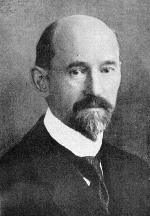Korbinian Brodmann: Difference between revisions
BreakfastJr (talk | contribs) →top: Fixed the birth-year given in the box, based on what other sources say and on what this article says in its first sentence |
Omnipaedista (talk | contribs) add place of death |
||
| Line 8: | Line 8: | ||
| birth_place = [[Hohenfels, Konstanz|Liggersdorf]], [[Province of Hohenzollern]] |
| birth_place = [[Hohenfels, Konstanz|Liggersdorf]], [[Province of Hohenzollern]] |
||
| death_date = {{Death date and age|1918|08|22|1868|11|17}} |
| death_date = {{Death date and age|1918|08|22|1868|11|17}} |
||
| death_place = |
| death_place = [[Munich]] |
||
| nationality = [[Germany|German]] |
| nationality = [[Germany|German]] |
||
| other_names = |
| other_names = |
||
Revision as of 00:32, 29 April 2014
Korbinian Brodmann | |
|---|---|
 Korbinian Brodmann | |
| Born | November 17, 1868 |
| Died | August 22, 1918 (aged 49) |
| Nationality | German |
| Occupation | neurologist |
| Known for | cerebral cortex |
Korbinian Brodmann (November 17, 1868 – August 22, 1918) was a German neurologist who became famous for his definition of the cerebral cortex into 52 distinct regions from their cytoarchitectonic (histological) characteristics, known as Brodmann areas.[1]
Life
Brodmann was born in Liggersdorf, Province of Hohenzollern, and studied medicine in Munich, Würzburg, Berlin and Freiburg, where he received his medical diploma in 1895. Subsequently he studied at the Medical School in the University of Lausanne in Switzerland, and then worked in the University Clinic in Munich. He got a doctor of medicine degree from the University of Leipzig in 1898, with a thesis on chronic ependymal sclerosis. He worked also in the Psychiatric Clinic in the University of Jena, with Ludwig Binswanger, and in the Municipal Mental Asylum in Frankfurt, from 1900 to 1901. There, he met Alois Alzheimer, who was influential in his decision to pursue neuroscientific basic research.
Following this, Brodmann started to work in 1901 with Cécile and Oskar Vogt at the private institute "Neurobiologische Zentralstation" in Berlin, and in 1902 in the Neurobiological Laboratory of the University of Berlin. In 1915 he joined the Kaiser-Wilhelm-Institut für Hirnforschung (Institute for Brain Research).
In 1909 he published his original research on cortical cytoarchitectonics in "Vergleichende Lokalisationslehre der Großhirnrinde in ihren Prinzipien dargestellt auf Grund des Zellenbaues" (Comparative Localization Studies in the Brain Cortex, its Fundamentals Represented on the Basis of its Cellular Architecture).
In the following years he worked at the University of Tübingen, where he was habilitated and made a full professor in 1913, and from 1910 to 1916 as physician and chairman of the Anatomical Laboratory at the University Psychiatric Clinic. In 1916 he moved to Halle in order to work in the Nietleben Municipal Hospital. Finally, in 1918, he accepted an invitation from the University of Munich to direct the group of histology at Psychiatric Research Center.
He died in Munich rather suddenly of a generalized septic infection following pneumonia, at just under 50 years of age on August 22, 1918.
Brodmann areas


The areas he depicted on the brain are now usually referred to as Brodmann areas. There are a total of 52 areas grouped into 11 histological areas.[2] Brodmann used a variety of criteria to map the human brain, including attention to gross anatomical features as well as the examination of cortical micro-structures.[3]
Brodmann postulated that these areas with different structures performed different functions.[4] Indeed, some of these areas were later associated to nervous functions, such as the following:
- Brodmann area 41 and 42 in the temporal lobe related to hearing
- Brodmann area 45 and 44 overlap with the Broca's area for language in humans
- Brodmann area 1 and 2 and 3 in the postcentral gyrus of the parietal lobe (the somatosensory region)
- Brodmann area 17 and 18 in the occipital lobe (the primary visual areas).
His work on identifying areas of cytoarchitecture was strongly influenced by Oskar Vogt, who postulated over 200 distinct areas in the brain.[1]
References
- ^ a b Stanley Finger (2001). Origins of Neuroscience: A History of Explorations Into Brain Function. Oxford University Press. pp. 42–. ISBN 978-0-19-514694-3. Retrieved 26 January 2013.
- ^ Edwin Clarke; Kenneth Dewhurst; Michael Jeffrey Aminoff (1996). An Illustrated History of Brain Function: Imaging the Brain from Antiquity to the Present. Norman Publishing. pp. 123–. ISBN 978-0-930405-65-6. Retrieved 26 January 2013.
- ^ Philosophy of Psychology and Cognitive Science: A Volume of the Handbook of the Philosophy of Science Series. Elsevier. 23 October 2006. pp. 147–. ISBN 978-0-08-046662-0. Retrieved 26 January 2013.
- ^ Mark F. Bear; Barry W. Connors; Michael A. Paradiso (2007). Neuroscience: Exploring the Brain. Lippincott Williams & Wilkins. pp. 197–. ISBN 978-0-7817-6003-4. Retrieved 26 January 2013.
External links
- Korbinian Brodmann (1868-1918) article by Professor Laurence Garey
- microscope for brain sections from the University of Tübingen (1911), attributed to Korbinian Brodmann's work (German language)
- Korbinian Brodmann WhoNamedIt
- 1868 births
- 1918 deaths
- People from Konstanz (district)
- German neurologists
- German neuroscientists
- History of neuroscience
- Deaths from sepsis
- People from the Province of Hohenzollern
- Ludwig Maximilian University of Munich alumni
- Ludwig Maximilian University of Munich faculty
- University of Würzburg alumni
- Humboldt University of Berlin alumni
- University of Freiburg alumni
- University of Leipzig alumni
- University of Tübingen faculty
- Infectious disease deaths in Germany
